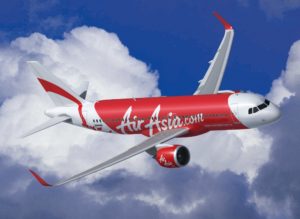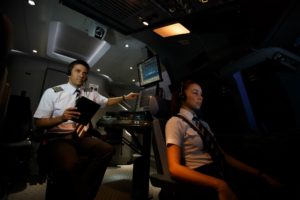Captain Lim Khoy Hing delves into the simple (and complex) truths about piloting different types of aircraft.

Pilots in the cockpit of a Boeing aircraft – Image Travel 3Sixty
Can an Airbus pilot also fly a Boeing plane (or vice versa)? The simple answer is, “No”; at least not without appropriate training on the different engine systems and flying techniques. The principles involved in flying a plane are different from those that apply to driving a car – piloting different types of planes is not as easy as a driver switching between two brands of cars.
Hi-tech Safety
Airbus first introduced the fly-by-wire (FBW) technology on the Airbus A320. This plane was launched in 1984 and its first commercial flight was in 1987.
With this technology, the flight control (known as the side stick) is not connected directly to the control surfaces. Instead, it is connected through a system of computers via electronic wiring, which by avoiding the use of mechanical cables, saves weight and improves efficiencies.
Information from the computers is processed and used to operate many automatic safety features. These include the alpha floor protection, which kicks in to prevent a plane from stalling, in accordance with normal flight control law. This technology is used in Airbus aircraft from the A320 to the A380 models.
The FBW technology was introduced 10 years later on the 777 aircraft by Boeing; its first flight was in 1994, and the first planes were delivered to United Airlines in 1995. My initial encounter with a FBW flight was on the Boeing 777.
Flying Philosophy
To switch from one plane to another, pilots need to know the different flying philosophies that apply to the two aircraft.

Flight simulators – Image Travel 3Sixty
Airbus prefers more automation to manoeuvre the plane with fairly rigid flying procedures, whereas Boeing allows pilots to override automation, providing more room for individual flying styles.
Generally, due to more automation, Airbus planes are easier to fly, whereas Boeing planes are more robust. But rest assured, both aircraft are equally superb.
Dual Qualification
It is not common practice for airlines to have a pilot flying two different types of planes in the same period of time.
Aviation regulations require that pilots be trained and certified on each aircraft that they may be assigned to fly. Hence, a pilot needs to undergo separate training (type rating) for each type of plane.
If a pilot flies two types of planes, it is not considered safe, as confusion can arise. As such, for safety reasons, many airlines prefer that their pilots fly just one specific type of plane.
Realistic Drill
For an Airbus pilot to fly a Boeing plane (or vice versa), he or she must complete a simulator training course, which takes six to eight weeks. Following that, line-training (piloting of a real airliner under the supervision of an instructor) is required before the pilot is competent to carry passengers on their own.
The transition training involves re-learning aircraft systems such as electrical and hydraulic operations, flight controls of the new plane, procedures and the pilot’s ability to handle inflight emergencies.
These are all carried out in the latest flight simulators, which are so realistic that take-off and landing can be perfected on the simulator itself.

An AirAsia Airbus A320 neo – Image Travel 3Sixty
Once pilots have undergone sufficient training on the simulator to develop their competency, they will operate a real airliner with an instructor and a safety co-pilot on board, in what is called line-training.
Today, the use of flight simulators has been highly cost effective and practical in pilot training. Many years ago, we had to shut down the plane engine in mid-air to practise single engine flying. I have to admit, this was a risky exercise, but we lacked specific simulators back then.
Flight simulators are very realistic, and pilots feel like they are flying a real plane. When mistakes made result in mishaps, the simulator can be reset and the trainees repeat the exercises until they have mastered them.

Pilot training in an Airbus flight simulator – Image Travel 3Sixty
Back to Basics
As you can see, there is a certain degree of transition training necessary before a pilot can switch planes. However, this does not mean that it is not possible, especially when the need arises, as in an emergency situation.
All pilots are trained in the basics of flying, which are the same whether they fly an Airbus or a Boeing. So, for instance, a Boeing pilot travelling as a passenger on an Airbus flight can still be relied upon to make a safe landing should the captain of the aircraft become incapacitated for some reason.
Safety is always at the forefront of commercial aviation, and I hope this month’s article helps you appreciate that piloting different aircraft is not as simple as switching cars.
With this, I wish you a safe and pleasant flight.
Posted: 17.04.18